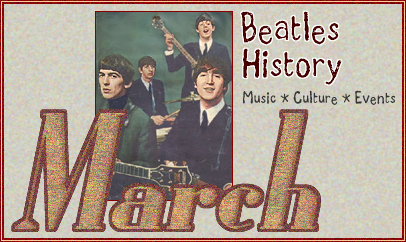 History offers History offers
a chance
to truly
understand
how the past
impacts the now.
Follow our
daily timelime
of historical
events to
discover the
role The Beatles
played in changing
the modern world.
THE FOLLOWING EVENTS TOOK PLACE ON MARCH 28
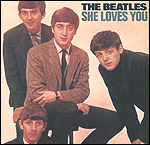 1960--Two anti-payola bills are introduced in Congress by Representative Emanuel Celler of New York. He blames payola for "the cacophonous music called rock and roll" and claims that rock and roll would never have achieved popularity, "especially among teenagers," if not for the result of payola. 1960--Two anti-payola bills are introduced in Congress by Representative Emanuel Celler of New York. He blames payola for "the cacophonous music called rock and roll" and claims that rock and roll would never have achieved popularity, "especially among teenagers," if not for the result of payola.
1962--The Beatles perform at the Cavern Club twice -- at lunchtime and at night.
1963--The Beatles, on the Chris Montez / Tommy Roe tour, perform at the ABC Cinema in Exeter, Devonshire.
1964--She Loves You is the #1 single in the US for the second week in a row.
1964--Radio Caroline debuts as the first pirate radio station to broadcast off the coast of England. The combination of rock music and lively disc jockey patter played to a huge audience in Great Britain; but well out of reach of the British authorities. Radio Caroline would become serious competition to the staid and usually dull British Broadcasting Corporation (BBC).
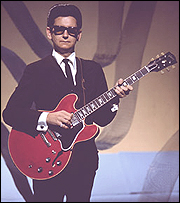 1965--The Beatles tape their final appearance on the ABC Television program, "Thank Your Lucky Stars." Recording takes place at Alpha Television Studios, Birmingham. The Beatles lip-sync to their songs Eight Days a Week, Yes It Is, and Ticket to Ride, before a very enthusiastic studio audience. Paul McCartney and Ringo Starr are interviewed by Brian Matthew. Broadcast on April 3. 1965--The Beatles tape their final appearance on the ABC Television program, "Thank Your Lucky Stars." Recording takes place at Alpha Television Studios, Birmingham. The Beatles lip-sync to their songs Eight Days a Week, Yes It Is, and Ticket to Ride, before a very enthusiastic studio audience. Paul McCartney and Ringo Starr are interviewed by Brian Matthew. Broadcast on April 3.
1966--Ringo Starr and George Harrison attend Roy Orbison's concert in Walthamstow, England.
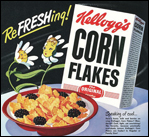 1967--The Beatles in the recording studio (Studio Two, EMI Studios, London). John Lennon records his lead vocal for Good Morning Good Morning. Paul adds a lead guitar solo and both John and Paul add backing vocals. John had decided that he wanted to end the song with animal sound effects, and asked that they be sequenced in such a way that each successive animal was capable of scaring or eating the preceding one. Suitable animal sound effects are found in the Abbey Road tape library: Volume 35: Animals and Bees and Volume 57: Fox-hunt. Later, additional overdubs are recorded for Being For the Benefit of Mr. Kite. Harmonica parts are added by George Harrison, Ringo Starr, Mal Evans, and Neil Aspinall. Paul adds a guitar solo and John adds an organ part. 1967--The Beatles in the recording studio (Studio Two, EMI Studios, London). John Lennon records his lead vocal for Good Morning Good Morning. Paul adds a lead guitar solo and both John and Paul add backing vocals. John had decided that he wanted to end the song with animal sound effects, and asked that they be sequenced in such a way that each successive animal was capable of scaring or eating the preceding one. Suitable animal sound effects are found in the Abbey Road tape library: Volume 35: Animals and Bees and Volume 57: Fox-hunt. Later, additional overdubs are recorded for Being For the Benefit of Mr. Kite. Harmonica parts are added by George Harrison, Ringo Starr, Mal Evans, and Neil Aspinall. Paul adds a guitar solo and John adds an organ part.
1969--Day 4 of John and Yoko's "Amsterdam Bed-In For Peace." They have an interview with Akiva Nof of the Voice of Israel, and John sings I Want You.
1969--In London, Ringo Starr says The Beatles will make no public appearances. John Lennon counters that there will be several in 1969.
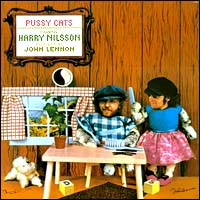 1974--At Burbank Studios in California, John Lennon starts producing the Harry Nilsson album Pussy Cats, for which he writes the song Mucho Mungo and records several demos of the song. John recalls the problems recording this album with Harry: “He’d lost his voice and I don’t know whether it was psychological or what. You know, he was going to doctors and having injections, and he didn’t tell me until later that he was bleeding in the throat, or I would have stopped the sessions. But he had no voice. So what do you do? Someone writes a story saying that he’s imitating me. He wasn’t imitating me. He couldn’t...he had no voice. But we were committed. The main thing is, we had a lot of fun. There was Keith Moon, Harry, Ringo and me all living together in the house and we had some moments. But it got a little near the knuckle. That’s when I straightened out. In the middle of the album. That’s when I realized ‘There’s something wrong here. I mean, this is crazy, man!’ I was suddenly the straight one in the middle of all these mad, mad people. I suddenly was not one of them. I pulled myself back and finished the album the best I could. I mean, we’d already spent the money. Everything was booked in. We had the tapes. So me and Harry had the best out of it, you know, because we spent a few good nights together.” Paul and Linda McCartney dropped by the session this night to watch the recording. Paul joins in a jam session with John and the others on Midnight Special, which is the first time he has played with John since the split of The Beatles fours years earlier. At the end of the day, John invites Paul to his beach house music session on the coming Sunday. 1974--At Burbank Studios in California, John Lennon starts producing the Harry Nilsson album Pussy Cats, for which he writes the song Mucho Mungo and records several demos of the song. John recalls the problems recording this album with Harry: “He’d lost his voice and I don’t know whether it was psychological or what. You know, he was going to doctors and having injections, and he didn’t tell me until later that he was bleeding in the throat, or I would have stopped the sessions. But he had no voice. So what do you do? Someone writes a story saying that he’s imitating me. He wasn’t imitating me. He couldn’t...he had no voice. But we were committed. The main thing is, we had a lot of fun. There was Keith Moon, Harry, Ringo and me all living together in the house and we had some moments. But it got a little near the knuckle. That’s when I straightened out. In the middle of the album. That’s when I realized ‘There’s something wrong here. I mean, this is crazy, man!’ I was suddenly the straight one in the middle of all these mad, mad people. I suddenly was not one of them. I pulled myself back and finished the album the best I could. I mean, we’d already spent the money. Everything was booked in. We had the tapes. So me and Harry had the best out of it, you know, because we spent a few good nights together.” Paul and Linda McCartney dropped by the session this night to watch the recording. Paul joins in a jam session with John and the others on Midnight Special, which is the first time he has played with John since the split of The Beatles fours years earlier. At the end of the day, John invites Paul to his beach house music session on the coming Sunday.
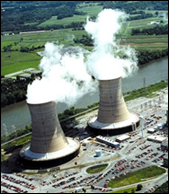 1979--A major nuclear accident occurs at Three Mile Island, Middletown Pennslyvania. 1979--A major nuclear accident occurs at Three Mile Island, Middletown Pennslyvania.
1986--Acting on a court order, EMI pays The Beatles back royalties in the amount of 2,832,264 pounds. A review of their overseas accounts is expected to bring in additional unpaid royalties, perhaps as much as another two million pounds.
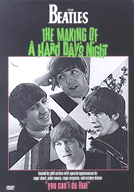
1995--MPI home video releases the one hour documentary “You Can’t Do That: The Making of A Hard Day’s Night.” Hosted by Phil Collins (who appeared in the audience during the concert sequence of the film at the Scala Theatre in London), the film features a behind-the-scenes look at the making of The Beatles' first film back in the spring of 1964. It also features the first release of the You Can’t Do That footage. It was cut from the film, but saved due to its airing on May 24, 1964, on the Ed Sullivan Show.
For more day-by-day history go to HistoryUnlimited.net
|
 History offers
History offers


